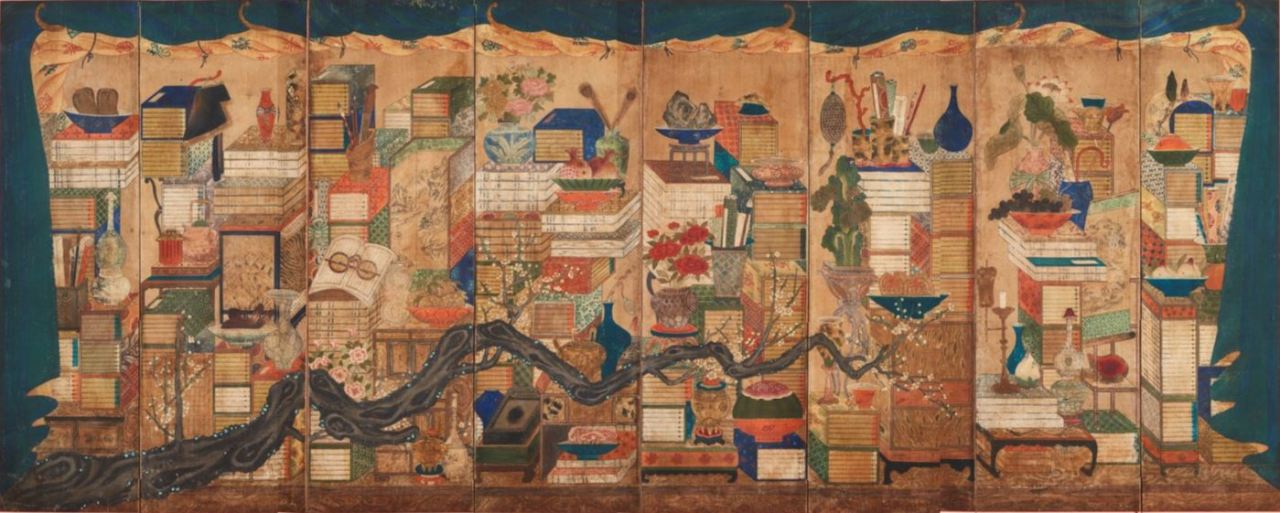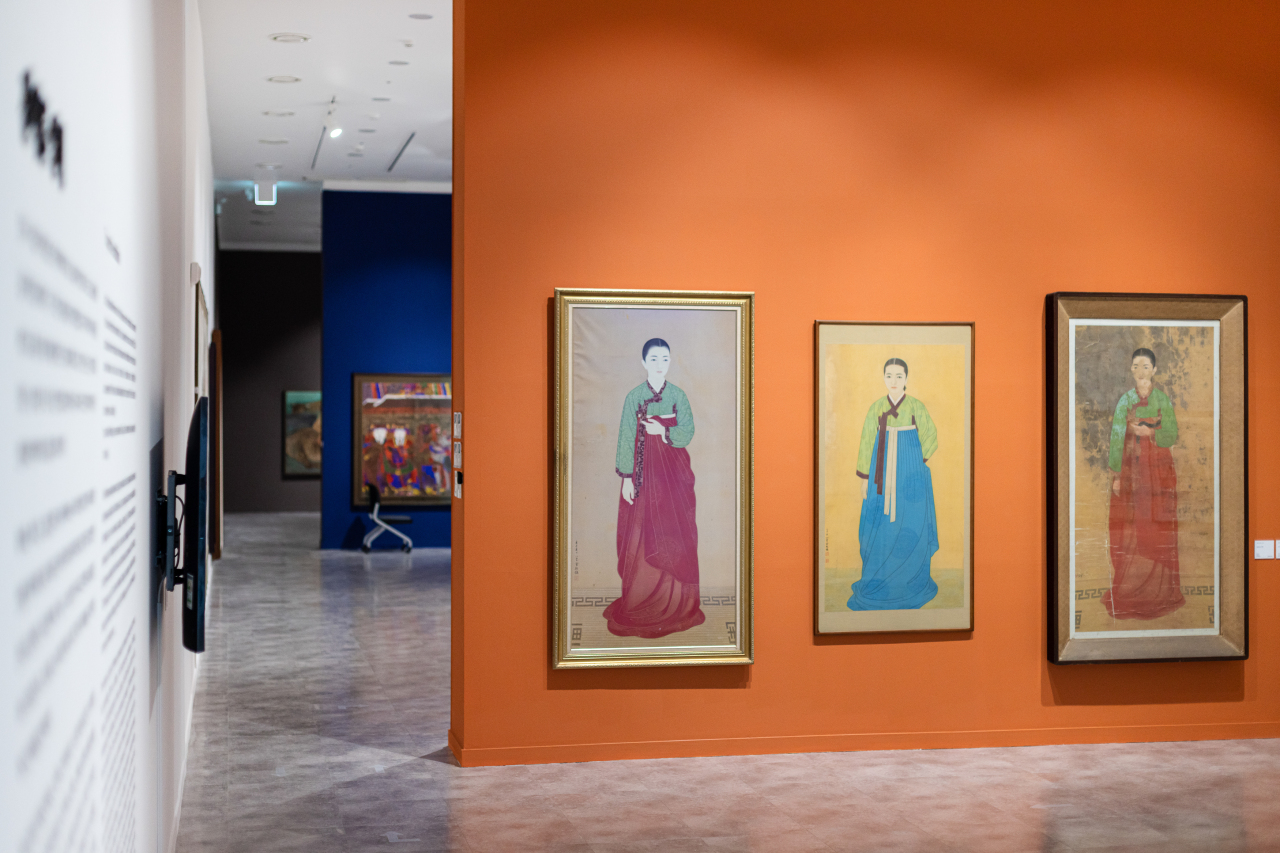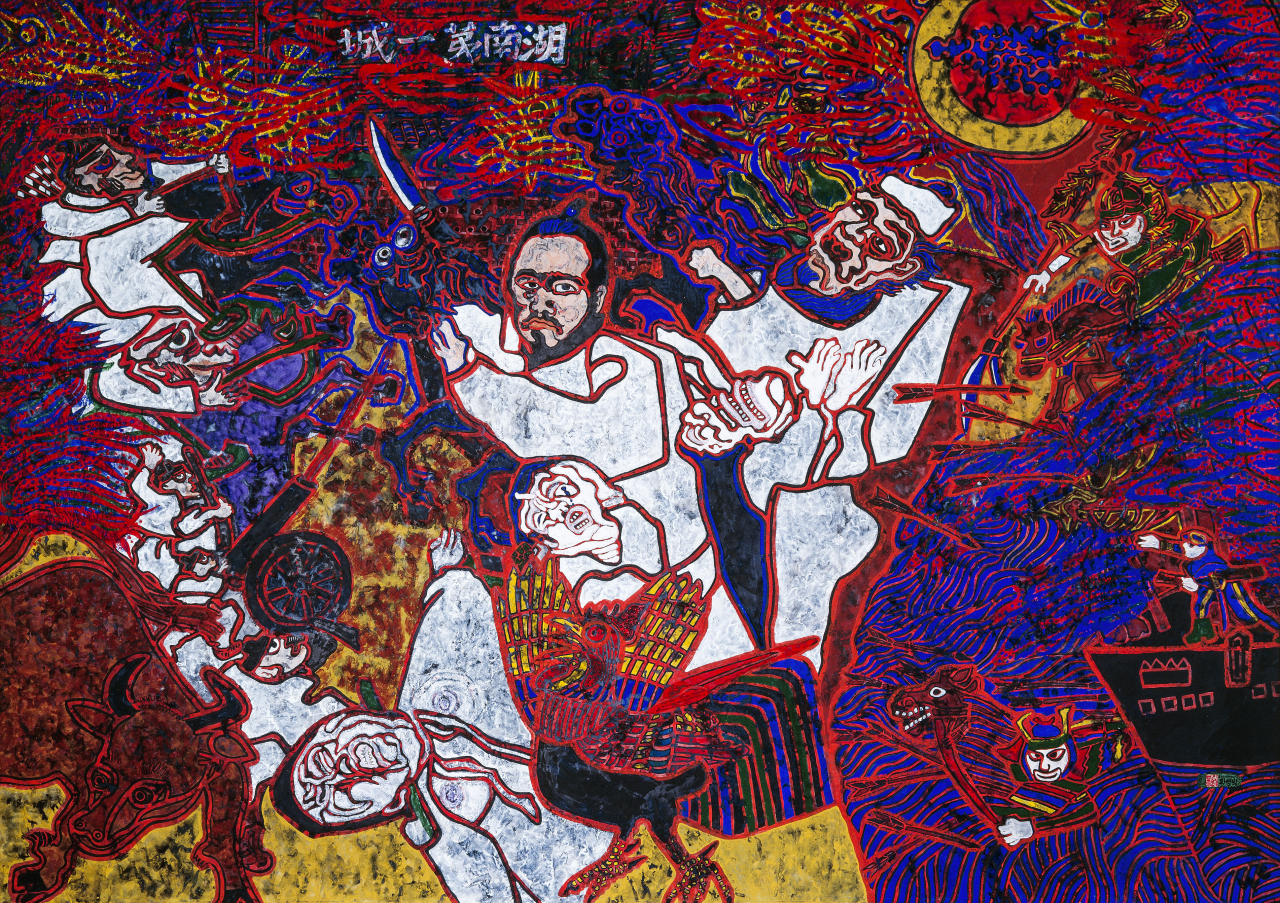 |
“Chaekgeorido with Plum Blossoms” from the 19th century is on display at the exhibition “Prayer for Life: Special Exhibition of Korean Polychrome Painting” at MMCA Gwacheon. (MMCA) |
A 3-meter-long folding screen shows a variety of books, fruits and other assorted items on bookshelves. The bright colors -- mainly blue, green and yellow -- are used to depict the items that symbolize prosperity. An old plum tree stretches across the panels of the folding screen.
The 19th-century folding screen painting “Chaekgeorido with Plum Blossoms” is on display at National Museum of Modern and Contemporary Art, Korea in Gwacheon, Gyeonggi Province, as part of the exhibition “Prayer for Life: Special Exhibition of Korean Polychrome Painting.”
The Korean painting genre “chaekgeori,” or also spelled as “chaekkori,” from the Joseon era is an example of how colors were employed in traditional paintings. The colors are vivid but are presented in harmony, giving them a natural vibe.
Ink wash paintings -- brush paintings executed with black ink -- are the dominant genre in most people’s minds when it comes to traditional Korean painting. The term “people of white garments,” referring to Korean people, and Joseon-period white porcelain jars are often thought to represent Korean aesthetics.
However, many colors were used in paintings as well as buildings. In architecture, “dancheong,” or traditional decorative coloring on wooden structures, were a common feature of traditional Korean buildings. In art, chaekgeori paintings that originated from royal paintings but later came to be regarded as “minhwa,” meaning folk painting, are traditional color paintings.
 |
“Fierce Tiger Woke Up” by Seongpa, at “Prayer for Life: Special Exhibition of Korean Polychrome Painting” at MMCA Gwacheon (MMCA) |
“Korea has a long history of polychrome paintings. As the national art museum, it is a shame that we did not curate any exhibition that focuses on Korea’s traditional color paintings,” MMCA director Youn Bum-mo told The Korea Herald at the “Prayer for Life: Special Exhibition of Korean Polychrome Painting” opening on May 31. The show is the first exhibition to explore how polychrome paintings were enjoyed in late Joseon era, and how their influence is still evident in the work of today’s artists.
Minhwa paintings that bloomed in the late Joseon era prevailed among common people while some originated from court paintings like chaekgeori. The subjects in the paintings such as fruits, letters, flowers and animals and those that symbolize prosperity -- peonies, pomegranates and watermelons -- frequently appear in the paintings.
“Minhwa is unique art because the genre only exists in Korea. There is no such art in other countries where people did a painting using primary colors, making a wish at the same time,” Youn said.
Experts regard the tomb mural paintings from the Goguryeo Kingdom (37 BC–AD 668) as crucial in the development of Korean polychrome paintings. Goryeo Kingdom (918-1392), which was based on Buddhism, also left valuable Buddhist paintings that used color, but only a few remain today. In the Joseon era when Confucianism prevailed, polychrome paintings were developed by court painters and later became prevalent among folk paintings.
Jinju National Museum and Rhee Seund Ja Jinju Museum of Art jointly held the exhibition “The Flow of Korean Polychrome Paintings” attracting some 71,000 visitors from March 22 to June 19, an exceptional number of visitors for a single exhibition, according to the two museums.
 |
An installation view of “The Flow of Korean Polychrome Paintings” at Jinju National Museum (Jinju National Museum) |
The exhibition covered Korean color paintings from Three Kingdoms period (57 BC to AD 668) to the modern and contemporary era. Lee Won-bok, a former chief curator at the National Museum, was among the group of art experts who curated the exhibition to raise awareness about Korean color paintings. Encouraged by the popularity of the recent exhibition, the two museums will host another minhwa exhibition next year.
“Of course it depends on the period, but is it not correct to say Korea’s traditional paintings are rooted in ink wash paintings,” Lee said.
While Buddhist paintings with colors and celadons prevailed during the Goyreo period, ink wash paintings became dominant in the Joseon era among the Confucian literati. Primary color paintings lost their prominence during the Joseon era as the Confucian ideal valued frugality and simplicity and minhwa paintings were regarded merely as decorative polychrome paintings.
Color paintings dismissed
The standing of Korea’s traditional color paintings slipped farther down in the post-colonial era -- Japanese colonized Korea from 1910 to 1945 -- when Korean art circles labeled some color paintings “vestiges of Japanese imperialism” or painters who learned color paintings in Japan as pro-Japanese artists. Many Korean artists had learned coloring in Japan where coloring techniques were advanced.
“After the liberation from Japan, Korean painters avoided pursuing polychrome paintings because they did not want to invite misunderstandings from the art circle,” said Chung Joon-mo, a former chief curator at MMCA and the director of the Korea Art Authentication and Appraisal Research Center.
Painter Park Saeng-kwang (1904-1985) was one of those artists. After studying art in Japan, he was rejected from the Korean art circle after Korea’s liberation from Japan, viewing his art as Japanese-style color paintings. A few years before his death, Park unveiled paintings in his own style, depicting Korean historical events using primary colors.
 |
“Jeon Bong-jun” by Park Saeng-kwang at the exhibition “Prayer for Life: Special Exhibition of Korean Polychrome Painting” at MMCA Gwacheon (MMCA) |
“He innovated his work, changing his coloring style in his later years,” Youn of MMCA said.
In recent years, minhwa has grown in popularity with an increasing number of people practicing the traditional folk art genre as a hobby and younger artists taking inspiration from it. Minhwa painter Oh Soon-kyung, who is showing five paintings inspired by minhwa at the MMCA exhibition that is running through Sept. 25, is one such artist.
Oh’s painting series, “The Five Guardian Deities,” shows five beasts that protect the five cardinal directions, prevalent in shamanism and Taosim -- a red phoenix in the south, black tortoise in the north, white tiger in the west, yellow dragon in the center and blue dragon in the east. Two to 3-meter-tall artworks are painted with pigments on hanji, or traditional Korean mulberry paper.
Further study on polychrome paintings of Goguryeo murals, minhwa, and today’s color painting is needed, according to experts.
“There are many artists who pursue traditional coloring techniques and materials even at universities. But we need more studies about Korea’s traditional art, which has been stalled since the 1970s,” said Chung Yeon-shim, a professor at the art studies department of Hongik University and a lead author of “Korean Art from 1953: Collision, Innovation and Interaction” published by Phaidon in 2020.
By Park Yuna (
yunapark@heraldcorp.com)











![[Today’s K-pop] Blackpink’s Jennie, Lisa invited to Coachella as solo acts](http://res.heraldm.com/phpwas/restmb_idxmake.php?idx=644&simg=/content/image/2024/11/21/20241121050099_0.jpg)